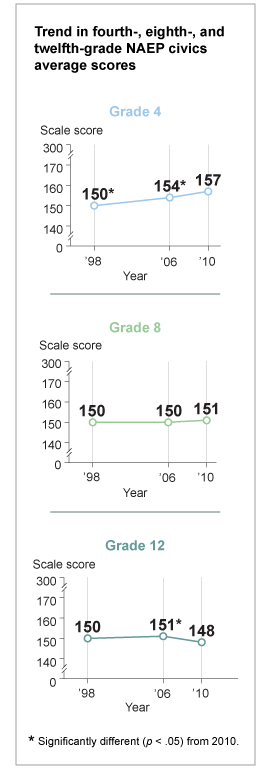|
Students make progress in civics at grade 4 but not at grades 8 and 12
Students in grades 4, 8, and 12 participated in the 2010 National Assessment of Educational Progress (NAEP) in civics. At each grade, students responded to questions designed to measure their civics knowledge, intellectual and participatory skills, and civic dispositions. Comparing the results from the 2010 assessment to results from two previous assessment years (1998 and 2006) shows how students' knowledge and skills in civics have progressed over time.
-
In comparison to earlier civics assessments in 2006 and 1998, the average score in 2010 was higher than the scores in both years at grade 4, not significantly different from the score in either year at grade 8, and lower than the score in 2006 but not significantly different from the score in 1998 at grade 12.
The percentages of students at or above Proficient in 2010 were higher than in 2006 and 1998 at grade 4, not significantly different from the percentages in previous assessment years at grade 8, and lower than 2006 at grade 12.
-
The percentages of students at or above Basic in 2010 were higher than in 2006 and 1998 at grade 4, but not significantly different from previous assessment years at grades 8 and 12.
-
There were no significant changes in the percentages of fourth-, eighth-, and twelfth-graders at Advanced in comparison to previous assessment years.
-
Average civics scores for Hispanic students were higher in 2010 than in 2006 at grade 8, and higher than in 1998 at all three grades.
-
The average score for female fourth-graders increased since 2006, while there were no significant changes in score for male fourth-graders over the same period.
-
The average score for female twelfth-graders was lower in 2010 than in 2006 and 1998, while there was no significant change in the score for male twelfth-graders in comparison to either year. There was no significant difference between the scores of female and male twelfth-graders in 2010.
-
In 2010, thirty-three percent of students attended schools where administrators reported focused instruction in civics/government in fourth grade; eighty-five percent of students reported learning about civics in eighth grade; and ninety-seven percent of students reported studying civics or government in high school.
Explore more results for civics.
Read about the civics framework and what the assessment measures.
For more information, browse the report online or download a copy of the report.
SOURCE: U.S. Department of Education, Institute of Education Sciences, National Center for Education Statistics, National Assessment of Educational Progress (NAEP), 1998, 2006, and 2010 Civics Assessments.
|